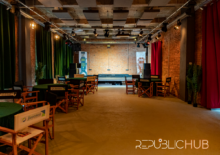Artivive is a solution, but also a revolution. A revolution in the way visual art is produced and consumed. The app provides artists with an augmented reality layer that adds to otherwise static creations, bringing them to life. For us, Artivive is a project of the heart, in which we have invested a lot, and now we have decided to present it to you.
What is Artivive?
It’s an augmented reality app that helps artists and creatives create more interactive, enhanced images that take their story beyond the physical medium into a digital realm. It’s an app that allows creators to create new dimensions of art by infusing them with a digital creation. The artist simply needs to create an account and log in to Artivive Bridge. They can then create a new work of art by adding on top of a target image, layers of images or video. By using simple tools such as transparency, scaling and rotating, the artist can modify and adjust elements in the image to achieve the desired result. Through augmented reality, artists can bring their work to life, providing a more immersive visual and interactive experience for the viewer. In short, Artivive enables creatives to create new dimensions of art by combining classical and digital art. Find more details in the video below:
Context and challenge
In early 2017, Artivive founders Sergiu Ardelean and Codin Popescu identified a unique opportunity to transform the interaction between art and technology. Artivive had the vision to integrate traditional fine arts with digital elements, thus offering a new dimension to the artistic experience. This challenge not only required technological innovation, but also had to be accessible, fast and scalable to dynamically adapt to the diverse requirements of artists and art institutions.
Specific objectives
To meet these needs, Reea was asked to provide a technological solution that would enable:
- Broad compatibility: support for a wide range of devices, including smartphones, tablets and smart glasses, essential for user accessibility.
- Performance: reducing latency and providing a smooth and responsive user experience, critical for augmented reality immersion.
- Implementing new functionality: integrating user feedback and market trends to further innovate and improve the platform.
- Seamless integration: ensuring seamless integration with the Artivive platform for content management and user engagement.
Strategy and planning
The planning and design phase lasted approximately three months and included intensive brainstorming sessions with stakeholders, artists and developers to define in detail the project’s scope and objectives. This phase was crucial for aligning visions and establishing a solid framework for the development phases to come
Technologies chosen
We opted to use the Unity development engine because of its Unity capabilities but briefly what are all the technologies used:
- Unity – Already mentioned powerful 3D rendering engine with a development platform, used for creating immersive augmented reality experiences.
- Artivive Image Recognition – We developed image and artwork recognition in the cloud using artificial intelligence
- Artivive Platform – A custom content management system and user engagement platform that allows artists and institutions to manage and publish AR content.
- Cloud services – We used cloud infrastructure for scalability, reliability and data management, ensuring a seamless user experience.
First release testing and validation
The testing and validation process was a key component in the development of the first version of the Artivive platform, ensuring that the final solution was not only functional, but also optimized for end-user experiences, including artists, galleries and museums. This included several crucial steps to ensure the quality and effectiveness of the technology developed.
Unit testing
The first stage of the testing process involved unit testing, where each individual component of the app was checked to ensure it worked correctly in isolation. This step is vital for identifying and correcting errors early in the development cycle. The Reea testing team used automated test frameworks to streamline this process, allowing for repeatability of tests and quick identification of regressions in code updates.
Integration Testing
After validating individual components, we moved on to integration testing. This level of testing checks how the various modules of the application interact with each other and with external systems. For Artivive, it was crucial to ensure that the image recognition system integrates seamlessly with the mobile app and content management platform. Integration testing helped to confirm that the entire system was working smoothly and efficiently, with no interruptions or performance issues.
User Acceptance Testing (UAT)
One of the most important phases of the testing process was User Acceptance Testing (UAT). In this phase, a select group of end-users – artists, museum curators and gallerists – were invited to use the platform under real-world conditions to assess its usability, functionality and performance. The feedback collected directly from end-users was essential for the final product adjustments. We organised workshops and feedback sessions to facilitate effective communication between users and the development team.
Post-launch monitoring
Then came the launch, which was a real success. But after launch, our team continued to monitor the performance of the application under various usage conditions to identify any issues that were not evident in the earlier testing phases. This monitoring process included collecting and analyzing usage data, evaluating user feedback, and cloud infrastructure performance. Any issues identified in this phase were quickly addressed to ensure a high-quality user experience.
Conclusions and continuous improvements
The rigorous testing and validation process allowed us to launch a robust platform that is well received by the arts community. Continuous improvements, based on feedback and analysis of usage data, ensure that Artivive remains at the frontier of AR technology in the arts, providing innovative and accessible tools for content creators around the world. This continued commitment to excellence in development and testing underscores our dedication to delivering an exceptional experience to all users of the Artivive platform.
Artivive now and plans for the future
Artivive is now a community of over 400,000 artists, brought together on an effervescent, ever-expanding platform. A tool that has recently been integrated into the Canva platform, so that the ease of creating designs in Canva is complemented by the ease of bringing them to life with Artivive. And in the coming months, Artivive will bring new functionality to its editor, template library, image recognition engine capabilities, as well as new generative capabilities using artificial intelligence. All in all, it’s been a very exciting journey for us, and we invite you to join it.





